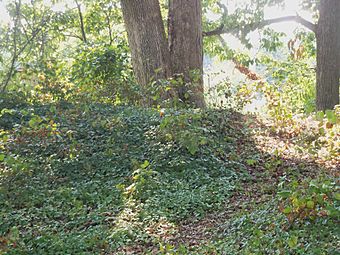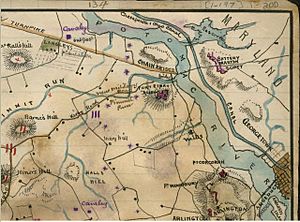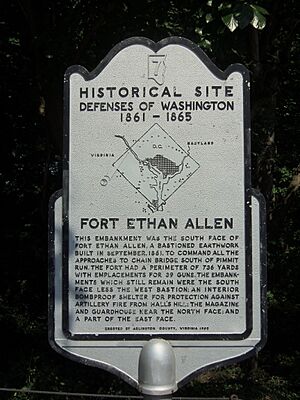Fort Ethan Allen (Arlington, Virginia) facts for kids
|
Fort Ethan Allen
|
|

A section of the earthworks that remain.
|
|
| Location | Address Restricted, Arlington, Virginia |
|---|---|
| Area | 9.8 acres (4.0 ha) |
| Built | 1861 |
| Architect | Barnard, Gen. John Gross |
| NRHP reference No. | 04000052 |
Quick facts for kids Significant dates |
|
| Added to NRHP | February 11, 2004 |
Fort Ethan Allen was a strong military base built during the American Civil War. The Union Army constructed it in 1861 in what is now Arlington County, Virginia. It was part of a big defense system around Washington, D.C., to protect the capital city. Today, you can still see parts of this old fort in Arlington County's Fort Ethan Allen Park.
Contents
History of Fort Ethan Allen
Why Fort Ethan Allen Was Built
The Union Army built Fort Ethan Allen in September 1861. This was soon after a big battle called the First Battle of Bull Run (Manassas). The Union Army had a tough time in that battle.
The fort was a large, star-shaped base located on high ground. It was near the Potomac River in northern Virginia. Before the fort was built, the area was mostly farms and forests. Soldiers cleared trees and plants. This was done so they could see other forts and any enemies approaching Washington, D.C.
How the Fort Was Designed
General John G. Barnard of the United States Army Corps of Engineers gave directions for building forts like this one. Fort Ethan Allen's walls were made extra strong. This was because it protected Chain Bridge, a very important way to get to Washington from the south.
Fort Ethan Allen and Fort Marcy were called the Chain Bridge forts. They greatly strengthened the defenses on the northern side of the Arlington Line. Because of its size and location, Fort Ethan Allen was a key part of Washington's defenses.
Fort Features and Connections
A network of trenches and roads connected the forts of the Arlington Line. These were used to move troops and supplies quickly. Fort Ethan Allen was also connected by long trenches to nearby Fort Marcy and the Potomac River.
The fort had four main sides, with extra angles on the north and east. It had a perimeter of about 700 meters (768 yards). There were places for 34 guns. Inside, the fort had two bomb-proof shelters. These were safe places from enemy fire. It also had ammunition magazines and other buildings.
In May 1864, a report described the fort's strength. It had many soldiers, over 1,300 men. It also had a lot of different guns. These included 6-pounder field guns, 10-pounder Parrotts, and 32-pounder bronze howitzers. There were also 24-pounder siege guns, 30-pounder Parrotts, and large mortars.
Wartime Events and Legacy
There was no fighting at Fort Ethan Allen during the Civil War. The only Confederate Army attack on Washington's forts happened north of the city in 1864. This was during the Battle of Fort Stevens.
One memorable event at Fort Ethan Allen was a visit by President Abraham Lincoln. He visited while the fort was being built.
In 1965, the Arlington County government put up a historic marker near the fort. The Arlington County Board made the fort a local historic district in 1978. The National Park Service listed the fort on the National Register of Historic Places in 2004.
In 2014, Arlington County added nine special signs in Fort Ethan Allen Park. These signs explain the fort's history. The Virginia Civil War Trails also placed a historic marker nearby.
What Remains Today
Fort Ethan Allen still has several important features above ground. These include large earthworks (mounds of earth). You can also see one bombproof shelter. There are also gun platforms and traces of the ammunition magazines.
The fort's remaining inside structures are still visible. This includes the fort's south side, the bombproof in the middle, and parts of the north side. An outer trench, which is also a local historic district, remains southwest of the fort.






